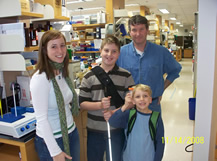Research
Research

Our overall goals are to provide better knowledge about the clinical manifestations of Batten disease, and to develop and test meaningful treatments for children with Batten disease.
Our current research falls into 4 basic categories:
- Natural History. The goal is to better understand how Batten disease progresses, how different symptoms interact to cause disability, and to identify potential factors that are related to fewer symptoms or less disability. We developed the Unified Batten Disease Rating Scale (UBDRS) to evaluate the severity and rate of change in the main symptoms of juvenile Batten disease. The UBDRS allows us to quantitatively measure the clinical aspects of juvenile-onset Batten disease (JNCL), and to measure the effects of future therapies on JNCL symptoms. We are also expanding the UBDRS to evaluate other forms of Batten disease.
- Neurobehavioral and Neurocognitive Features. The goal of this research is to define the specific behavioral and cognitive features of Batten disease and to develop strategies to minimize the impact of these symptoms on the quality of life of patients and their families.
- Determinants of JNCL Severity. Our studies to date have demonstrated that some individuals with JNCL have a milder disease progression, while others have a more rapid disease progression. This variability does not seem to be due simply to different specific mutations in the CLN3 gene that causes JNCL. We are working to understand what factors do determine disease severity. One factor may be the sex of the individual, with females appearing to have a somewhat more rapid progression of disease (see publication by Cialone et al., 2012).
- Experimental Therapeutics. A major emphasis of our research is to design and carry out meaningful clinical trials of promising therapeutic agents in JNCL.